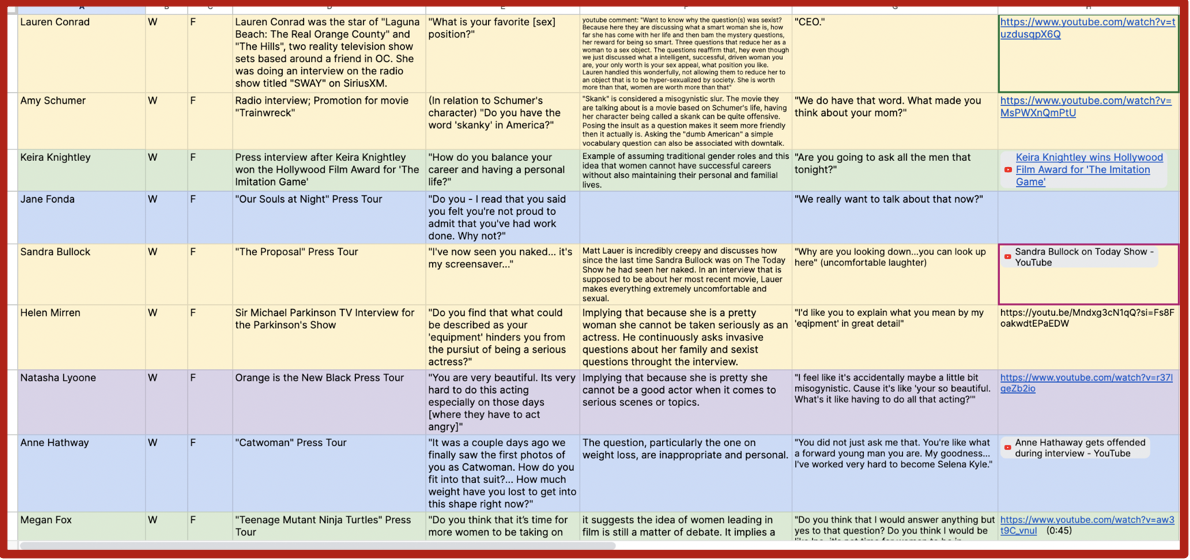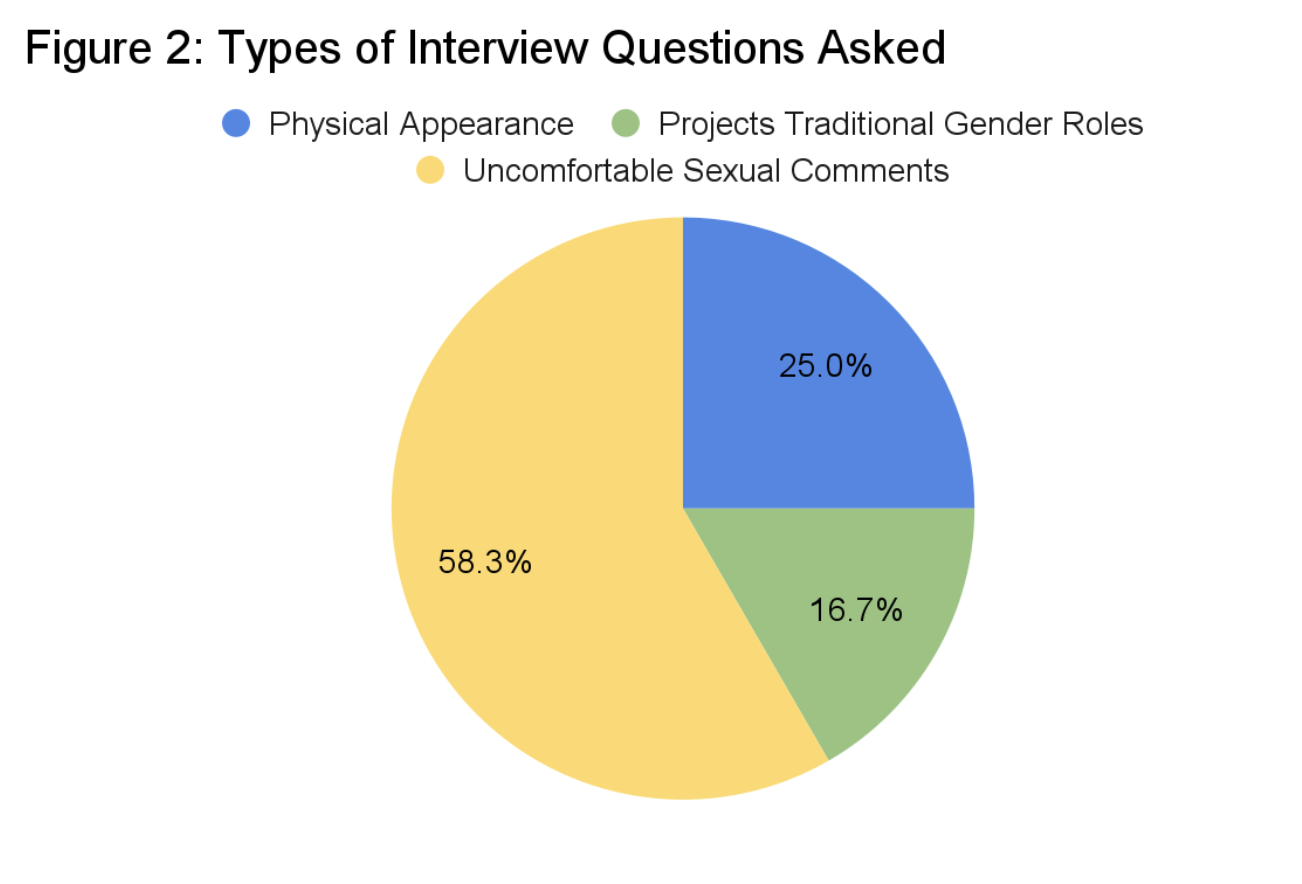Emily Chinn, Kai Wang, Soleil Danico, and Takuma Sato
In order for a movie to become a blockbuster, it needs to be properly promoted. Press tours are some of the most common tactics for garnering attention for an upcoming film and give the actors the platform to showcase their passion and personality. Still, the differentiation of questions and communication between actors and actresses is undoubtedly prevalent. The present article focuses on identifying the distinct patterns of gendered communication evident in celebrity press tour interviews. By viewing and analyzing the press tour interviews of actresses, we found a common pattern of questions that focus on physical appearance, project traditional gender roles, or are uncomfortable and unnecessarily sexual. Our results led us to the conclusion that there is a distinct gendered difference in the word choice and questions of actresses and actors, prompting the urge for more equitable questions and proper training in the entertainment industry.
Introduction The entertainment world has the unique ability to draw in an audience and influence populations across the world. Aspects of what is portrayed on the screen often come to fruition in the real world. Stereotypes and generalizations have not only been created, but perpetuated by content in cinema. One of the most caricatured groups in film throughout the years has been women. Women have been sexualized or deemed as unimportant for years through the history of filmmaking. Whether it be female characters having no motives in movies that do not relate to men, or simply being figures to gawk at, women have been objectified in films for years creating a societal image of women being weak and simple-minded. With film’s unparalleled ability to create a social impact, “vast numbers of movie-goers are receiving specific cultural messages, and the perpetuations of these themes regarding gender roles, which are depicted across genres in the top grossing films, [and] are reaching a huge audience” (Murphy, 2015). Unfortunately, in film media today, actresses are still subjected to sexist and dehumanizing questions in press tour interviews. Actresses are much more likely to receive questions that focus on physical appearance, that project traditional gender roles, or are uncomfortable due to their promiscuity. In order to dive deeper into this pervasive issue in Hollywood and the greater media, we performed an analysis of the word choice utilized in press tour interviews to identify the designs used to form these questions, ultimately answering: What are the distinct patterns of gendered communication evident in celebrity interviews? Background The manner in which celebrities are interviewed can significantly impact the outcome of the conversation. This is particularly evident in interviews with renowned actresses, where the gender of the interviewer can influence the nature of the questions asked. Studies have shown that female celebrities are often asked more personal questions, which can make them feel uncomfortable. This is not just a minor issue but a prevalent phenomenon that can affect how people perceive women in general. A study by Benney et. al titled “Age and Sex in the Interview”, indicates that female interviewees are more forthcoming and at ease when the interviewer is also female. This illustrates the impact of the gender of the interviewer on the course of the conversation (1956). Fu et. al, observed a phenomenon in sports interviews where female athletes are often asked about their personal lives instead of their athletic achievements, in contrast to male athletes (2016). This reflects a similar issue in Hollywood that helped to inspire our initial research study. Robin Lakoff studies gender communication and the qualities of women’s speech. Her research into the phrases and words that women utilize to handle uncomfortable questions helped us recognize patterns in actresses’ responses (1973). By analyzing the manner in which interviewers pose questions and actresses respond, we aim to gain insight into the unspoken rules and expectations that influence how we discuss men and women in the media. Methods To narrow our investigation and minimize the impact of external factors, we specifically chose to draw our data from press tour interviews after the respective actress/actor released a new project. We chose press tour interviews with the expectation that the questions would be about the current project, so any unrelated questions would help support our hypotheses. If we had chosen a book tour or general interview, most questions would be fair game and would not help us to analyze the gender and sexist interview questions/comments towards these actresses. Additionally, we maintained the same race for all of the interviewees and focused on white actresses and actors. Overall, we collected 15 different data samples. We gathered our clips from Good Morning America, Extra TV, and individual/non-affiliated interview Youtube channels. In order to analyze and organize the distinct patterns of gender communication, we created a codebook that categorizes the blatant sexism and misogyny witnessed in these interviews into three main categories. We transcribed all of the interviews and focused specifically on word choice within the interview question, and the interviewee’s response. We organized all of our data in a Google Spreadsheet and color-coded by the type of question. Blue is correlated with questions about physical appearance, Green is correlated with questions focused on projecting traditional gender roles, and Yellow is correlated with uncomfortable sexual comments. Figure 1 displays our data collection spreadsheet color-coded based on our Codebook. With prior knowledge of the gender dynamics in Hollywood, we hypothesize that sexist and gendered communication patterns are still extremely prevalent in press tour celebrity interviews. We also hypothesize that interviewers will spend more time focused on the three codebook categories than the actual content of the movie. Data and Results After establishing our three different categories of word choice, we analyzed the 15 samples and found that the most common type of questions asked were uncomfortable and sexual. Figure 2: Pie Chart represents the percentage of each question asked, according to our Codebook. In order to get a better sense of how we sorted each sample, an example of each will be given. Video 1A displays Anne Hathway’s “One Day” Press Tour Interview Video 1B displays Keira Knightley’s “The Imitation Game” Press Tour Interview Video 1C displays Sandra Bullock’s “The Proposal” Press Tour Interview Both Anne Hathway and Sandra Bullock respond with polite humor as a way to minimize the impact of the situation and move on from the question, as seen in Lakoff’s research. Discussion and Conclusions As our results show, the gendered communication and word choice for women in the film industry is negatively displayed through press interviews and tours. We found that actresses are more likely to be asked questions that are unrelated to the project that they are working on, with interviewers opting to spend more time asking personal questions rather than work related ones. This not only undermines the work that actresses put into their projects, but also projects an standard and ideal that impacts how women are perceived outside of the movies. It is important to recognize that we studied gendered communication through a binary of male and female actresses, yet we recognize that gender is not binary and further research can be done into the word choice in interview questions for non-binary, transgender, and other actors/actresses. Additionally, if the project were to be replicated, there are other limitations that could be addressed to create more accurate results. First, we did not choose a specific time period. While we limited our data to focus on press tour interviews, our interviews spanned the past 24 years and did not account for changes in the gender dynamics of Hollywood, the development of the #MeToo movement, and more. If replicated, we would narrow our scope to look at a specific celebrity event, award show, or 2-3 year span. As a result of our expansive time frame, there were many different individuals and media channels that conducted these interviews. References BoonieHu. “Sandra Bullock on Today Show.” YouTube, 21 Dec. 2009, youtu.be/k8Rk22-VAvs. Behm-Morawitz, Elizabeth, and Dana E. Mastro. “Mean Girls? The Influence of Gender Portrayals in Teen Movies on Emerging Adults’ Gender-Based Attitudes and Beliefs.” Journalism & Mass Communication Quarterly, vol. 85, no. 1, Mar. 2008, pp. 131–146, https://doi.org/10.1177/107769900808500109. Benney, Mark, et al. “Age and Sex in the Interview.” American Journal of Sociology, vol. 62, no. 2, Sept. 1956, pp. 143–152, https://doi.org/10.1086/221954. Chen, Yan. “Unveiling the Veil of the Damsel in Distress in Movies: The Impact of Gender Stereotypes on Female Characters in a Patriarchal Society.” Arts Culture and Language, vol. 1, no. 4, 3 Jan. 2024, https://doi.org/10.61173/m8eryy83. Chris Van Vliet. “Anne Hathaway Gets Offended during Interview.” YouTube, 9 Aug. 2011, www.youtube.com/watch?v=S3-5e0OOLKQ. Collins, Rebecca L. “Content Analysis of Gender Roles in Media: Where Are We Now and Where Should We Go?” Sex Roles, vol. 64, no. 3-4, 22 Jan. 2011, pp. 290–298, link.springer.com/article/10.1007/s11199-010-9929-5, https://doi.org/10.1007/s11199-010-9929-5. Digital Spy. “The Avengers UK Press Conference in Full.” YouTube, 20 Apr. 2012, www.youtube.com/watch?v=wBbSNnGmPfw. digitalmediafan. “At 30 Years Old This Is the the Infamous Helen Mirren Interview from 1975 with Sir Michaël Parkinson.” YouTube, 19 Aug. 2023, youtu.be/Mndxg3cN1qQ?si=Fs8FoakwdtEPaEDW. extratv. ““The Avengers” Interviews: Scarlet Johansson and Jeremy Renner.” YouTube, 3 May 2012, www.youtube.com/watch?v=DHxzxgwJTFc&t=19s. Fu, Liye, et al. “Tie-Breaker: Using Language Models to Quantify Gender Bias in Sports Journalism.” ArXiv (Cornell University), 13 July 2016, https://doi.org/10.48550/arxiv.1607.03895. GoldDerby / Gold Derby. “Keira Knightley Wins Hollywood Film Award for “the Imitation Game.”” YouTube, 14 Nov. 2014, www.youtube.com/watch?v=OIpcaMKmalA. Han Solo. “Watch Amy Schumer Shut down Interviewer after “Skank” Question.” YouTube, 9 Aug. 2015, www.youtube.com/watch?v=MsPWXnQmPtU. Heldman, Caroline, et al. “‘Hot, black leather, whip.’” Sexualization, Media, & Society, vol. 2, no. 2, 25 Apr. 2016, p. 237462381562778, https://doi.org/10.1177/2374623815627789. Lakoff, Robin. “Language and Woman’s Place.” Language in Society, vol. 2, no. 1, 1973, pp. 45–80, web.stanford.edu/class/linguist156/Lakoff_1973.pdf, https://doi.org/10.1017/s0047404500000051. MsMojo. “Top 20 Celebs Who Shut down Sexist Interview Questions.” YouTube, 25 Oct. 2020, www.youtube.com/watch?v=aw3t9C_vnuI%E3%80%80. Murphy, Jocelyn. “The Role of Women in Film: Supporting the Men — an Analysis of How Culture Influences the Changing Discourse on Gender Representations in Film.” Journalism Undergraduate Honors Theses, 1 May 2015, scholarworks.uark.edu/jouruht/2. shaniqua davidson. “OITNB’s Natasha Lyonne Drags a Sexist Reporter.” YouTube, 19 June 2015, www.youtube.com/watch?v=r37lgeZb2io. Speer, Susan A. “Sexist Talk: Gender Categories, Participants’ Orientations and Irony.” Journal of Sociolinguistics, vol. 6, no. 3, Aug. 2002, pp. 347–377, https://doi.org/10.1111/1467-9481.00192. SWAY’S UNIVERSE. “Lauren Conrad Answers Mystery Sack Question about Her “Favorite Position” on #SwayInTheMorning.” YouTube, 18 Oct. 2012, www.youtube.com/watch?v=tuzdusqpX6Q.

